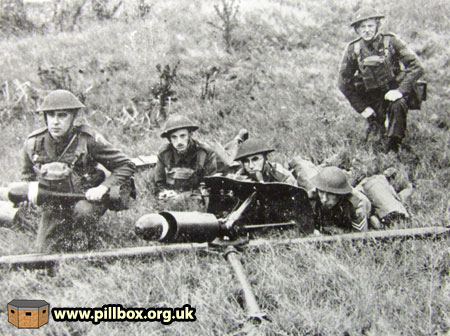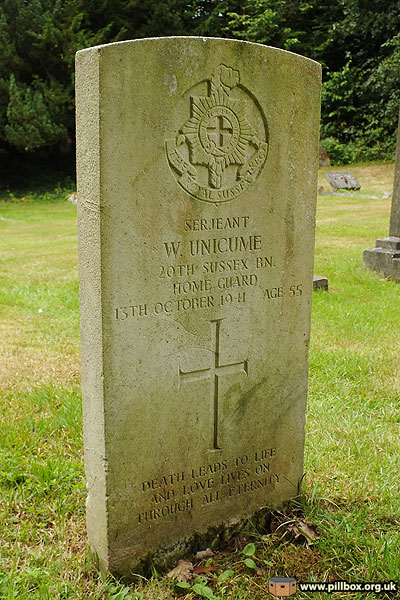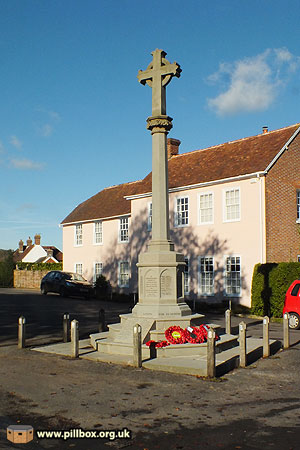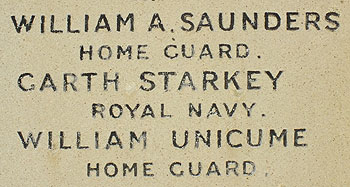In Remembrance
Posted: 10 November 2013 20:04
In previous years my In Remembrance blog entries have focussed on army and civilian deaths - this year I look at civilians in battledress - the Home Guard.
The Army and Home Guard were issued with a variety of hastily-developed weapons during World War Two; most were crudely constructed and proved unpopular. A demonstration of one such weapon at Horam in 1941 resulted in tragedy; a few references in documents have enabled me to piece together the story over a couple of years.
The 29mm Spigot Mortar (also known as the Blacker Bombard after its inventor) was introduced in 1941 predominantly as an anti-tank weapon for both the Army and Home Guard.
Crudely made, the mortar fired a large bulbous bomb by firing a spring-loaded spigot into its tail, igniting the propellant.
The bomb employed a hollow charge that was effective against armour, although an anti-personnel bomb was also developed.

The weapon was fired either from a 'portable' four-legged mount, or from a static concrete pedestal. Bulky and unwieldy, it's fair to say that the Bombard was unpopular from the start.
The photograph at right illustrates the field mounting and crew layout.
The date of this photo is not known, neither is the location, but it appears to show a training exercise using sand-filled dummy bombs.
This picture comes from a history of the 20th (Hailsham) Battalion of the Sussex Home Guard, published in December 1944 and is quite poignant as it depicts men who may well have witnessed the tragedy of October 1941.
The Demonstration
A weapons demonstration was being held at Horam Brickworks on 12th October 1941 for the Home Guard, at which military personnel were also present. The event was actually organised by the Royal Engineers of 55 Infantry Division.
At this date, IV Corps was responsible for the defence of Sussex with its three infantry divisions, 55 Division occupying East Sussex. Personnel from both of these formations were present, and pieces of the story have been compiled and collated from the records and war diaries at both levels.
The demonstration included the firing of anti-tank mines, grenades, the Thompson sub-machine gun and the Blacker Bombard. Among those present were the Commander of IV Corps, Lt-General F. P. Nosworthy, 55 Division's Commander Major-General W.D. Morgan and his Divisional CRE (Commander, Royal Engineers), Lt-Colonel Gornall, who had organised the event.
The war diary of the CRE takes up the story:
During the moring and early afternoon lectures on the equipment were given and then a practical demonstration at 15:00 hours. In the course of this demonstration a Blacker Bombard bomb burst in the gun, causing injuries to many persons. 12 persons were admitted to hospital.
Maj-Gen. Morgan, Lt-Col. Gornall, and a Captain Kepple-Palmer (Nosworthy's Aide-de-Camp) were amongst those injured. The Home Guard also suffered some casualties.
According to 55 Division's Assistant Director of Medical Services (ADMS):
The medical arrangements for the demonstration were satisfactory, one ambulance with orderlies, two medical officers and dressings were available. Enough ambulances and help were immediately sent by both 177 and 178 Field Ambulances.
177 Field Ambulance record Maj-Gen. Morgan's arrival in an ambulance at their HQ at Waldron; he was immediately transferred to hospital at Tunbridge Wells in Kent, described as being "considerably shocked."
The major casualties were sent to two hospitals in Tunbridge Wells, the Kent & Sussex and the Pembury Hospitals.
The CRE diary again:
20:00 hours: Reports from the hospital indicate that O.C. 55 Division (Maj-Gen. Morgan) has a small piece of metal somewhere near the kidney and is very ill. CRE has lost an eye... One Home Guard is certain to die.
The table below has been compiled from data taken from 55 Division's HQ (GS) diary entry for October 12th:
| Army Casualties | ||
|---|---|---|
| Maj-Gen W.D. Morgan | Stomach wound | Dangerously ill |
| Lt-Col Gornall | Loss of eye | Serious |
| Capt Kepple-Palmer | Facial injury | Serious |
| Sapper McLucas | Chest wounds and right arm | Not serious |
| Home Guard Casualties | ||
| Major Birley | Right eye | Serious |
| Major Hacking | Wound left jaw | Not serious |
| Sgt Unicume | Died of wounds | |
| Maddison | Extensive laceration of right arm and wrist - arm amputated | Minor |
| Watley | Bomb wound right thigh | Minor |
| Saunders | Gun shot wound small of back | Minor |
The same diary tells us that Maj-Gen Morgan's condition had improved and that he was off the danger list by October 29th. Despite the grievous wounds suffered by other Army personnel, it would seem that there were no fatalities among them.
Not so the Home Guard.

Sergeant William Unicume
As mentioned above, Sergeant Unicume was gravely injured in the accident and he passed away the following day.
An inquest was held on October 16th, the verdict of Accidental Death being recorded.
Unicume's funeral was held at 15:00 the next day, attended by 2nd Lieutenant Hargreaves of the Royal Engineers, who had also attended the inquest.
William Unicume was interred in St. Mary's Churchyard at Platt, Kent, 10 miles north of Tunbridge Wells, where he died.
I have no explanation as to why he lies here; it is by no means the nearest burial ground to where he died.
The next-of-kin of service personnel who died in the UK could pay for their loved one to be transported back home, but not all could afford this. (Personnel known to have died in East Sussex are buried in cemeteries as far away as Edinburgh.)
Platt Churchyard has only one other WW2 burial whose next-of-kin seemingly lived in the village.
The Commonwealth War Graves Commission database lists Unicume's wife, Agnes, as being from Ashford, (presumably the one in Kent) which is 25 miles away.
However, Unicume is commemorated on a war memorial in a village just two miles from Horam; more about this memorial later.
The aftermath of the incident
What had caused the Spigot Mortar bomb to detonate prematurely? A Court of Inquiry was initiated at 10:00 the day after the incident and concluded on October 14th. Evidence was heard from witnesses and experts, aside from those in hospital. Even Lt.-Colonel Blacker, the weapon's inventor, was present. According to the 55 Division CRE diary, "there was much theorising into the cause of the accident."
At this point the document trail almost went cold; 55 Division began moving out of Sussex just two days after the accident and were relieved by the Canadians.
About two years after I began researching this incident, I located some documents from Southern Command (East Sussex was in South Eastern Command) dated October 15th, the day after the conclusion of the Court of Inquiry. All ammunition with a Lot Number lower than 50 was to be returned to ordnance depots. This is important because these documents were copied to all Commands, meaning that the effects of the tragic accident at Horam impacted across the entire nation.
In another lucky archive find, I chanced upon a Canadian document dated November 3rd - three weeks after the accident. The document outlines the findings of the Court of Inquiry.
It was stated that an accident had occurred - but not that life had been lost.
It appears that the fuze employed on that fateful day had been supplied loose and a rubber pad that indicated which way round the fuse was, had become detached. This, it was believed, lead to the fuse being inserted the wrong way round, causing the premature detonation when the weapon was fired.
The document concludes:
The Court consider the explosion must be considered as an abnormal accident. All users of the Blacker Bombard should be made aware of the above facts, since it is important that confidence in a good weapon should not be destroyed by one accident.
This highlights the tragedy; it was an accident waiting to happen and if it hadn't happened at Horam, then it might well have happened elsewhere.
A second fatality
However, this is not the end of the story. The aforementioned history of the 20th (Hailsham) Battalion of the Sussex Home Guard states that: "Unfortunately several members of the Battalion attending a regular Army demonstration were involved in a premature explosion during the firing of a new weapon. Two members of the Battalion lost their lives."
The official documents make no mention of this second death; as 55 Division were emotionally attached to the incident, they might have mentioned another Home Guard death. However, the Division's move two days afterwards broke their link with Sussex, and the succeeding Canadians would not have followed up the situation as they had no connection to the incident.

Private William Saunders
When I first became interested in this incident and before I had identified Sgt. Unicume as the 'only' fatality from the documents, I had speculated that a Private Saunders might have been involved.
I had known of a Home Guard headstone in Hellingly Cemetery for a long time, having visited it over 20 years ago.
William Saunders died on April 2nd 1942, some six months after the accident. He was also in the 25th (Southern Railway) Battalion and not the 20th (Hailsham) Battalion, but I still believe that he must be the second victim of the explosion.
I base this on the casualty table above, which lists a Home Guard by the name of Saunders as having a minor injury. No other Home Guard deaths can be identified using the other names on this list.
I believe that Private Saunders eventually succumbed to wounds received as a result of the Horam accident, despite their being regarded as minor at the time.
He, too, is not buried in a logical cemetery; his wife, Ethel is listed as being at Horam, three miles from Hellingly. There was an Army General Hospital at Hellingly, in the grounds of the County Mental Asylum, and it may be that Saunders was being treated here when he died.
His name does not appear on the Hellingly War Memorial that stands a matter of yards from where he lies, so he was not from the village.

The Waldron War memorial
A chance discovery revealed that William Unicume was commemorated on the memorial at Waldron, a small village two miles NW of Horam.
Waldron is a typical example of a chocolate-box Sussex village; the war memorial stands in the middle of a road junction, with a church and pub on opposite sides of the road.
I duly found Unicume's name on the additional 1939-45 memorial tablet and then had a surprise by seeing Saunders listed there too!

The names on the memorial are repeated on a wall tablet in the nearby church.
This is the final piece in the jigsaw; two members of the Home Guard, from the same small village must surely have both been at an organised demonstration that significantly attracted the attention of an Army Corps Commander.
That a man by the name of Saunders is listed as a casualty, for me, identifies William Saunders as the second fatality of the accident.
Every war grave has a story behind it but not every story is always forthcoming from the records. Army war diaries will usually mention the deaths of Service personnel, but information about the Home Guard is scarcer.
I know of a handful of Home Guards buried in East Sussex and I'm not convinced that I'll be able to tell all of their stories from the usual archive documents.
It's taken a few years, but at least now two graves 28 miles apart have finally been connected to the same incident, and the tragic circumstances of two Home Guard volunteers told.
- Pete

Email:
Blog Latest

Bishopstone reveals its pillbox secrets
18 October 2021

Pillbox or Observation Post?
10 June 2020

Uncovering the hidden secrets of a pillbox
8 June 2019

Review of 2018
31 December 2018

Wartime Christmas in East Sussex (2)
24 December 2018
Jargon-buster
War diary
A record of events kept by all units from the point of mobilisation. A diary's contents vary enormously from unit to unit; some give detailed entries by the hour on a daily basis while others merely summarise events on a weekly/monthly basis.
This site is copyright © Peter Hibbs 2006 - 2024. All rights reserved.
Hibbs, Peter In Remembrance (2024) Available at: http://www.pillbox.org.uk/blog/216735/ Accessed: 24 April 2024
The information on this website is intended solely to describe the ongoing research activity of The Defence of East Sussex Project; it is not comprehensive or properly presented. It is therefore NOT suitable as a basis for producing derivative works or surveys!